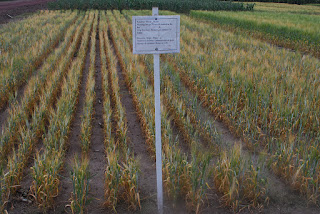These mushrooms are the fruiting structures of a group of fungi called basidiomycetes. The mushrooms are small parts of these organisms, which include extensive underground networks of hyphae, slender filaments that take up water and carbohydrates. A single individual fungus can send up fruiting bodies over an area as big as a baseball diamond.
Invisible to me, even after welcome rain, are two huge groups, the saprophytic and mycorrhizal fungi. Saprophytic fungi are decomposers, breaking down dead organic material, including wood, into nutrients plants can use.
Mycorrhizal fungi join in a symbiotic relationship with plant roots. Thinner and more extensive than root hairs, their hyphae seek out water and nutrients from far and wide. They share these with plants in return for simple sugars.
 |
| Fungal hyphae |
Some mycorrhizal fungi excrete a sticky polysaccharide called glomalin that glues soil particles together in small clumps called macroaggregates. These clumps improve growing conditions for roots by creating pore spaces in the soil for water and air. As if that weren’t enough, fungi in the soil also sequester carbon, attack plant pathogens, and cultivate helpful bacteria.
Luckily the best way to foster these useful partners is to stay out of their way. If I tilled my soil with a rototiller, I’d be breaking up their networks. If I sprinkled chemical fertilizer, I’d turn off their nutrient-collecting efforts. Fortunately there’s no call to do either in my garden. If I need to plant something, I get along fine by digging an appropriately-sized hole. Compost and mulch are providing enough nutrition for my plants.
 |
| Offering a home for soil fungi |
It turns out that by mulching with fall leaves and wood chips, I was unknowingly creating a happy environment for soil fungi. I learned about this when I researched the reasons for balancing types of ingredients in the compost pile. Before this I’d thought compost recipes were unnecessarily fussy.
Compost professionals can titrate ingredients and conditions in their compost piles to determine the proportion of bacteria and fungi in the finished product. By managing the balance of “brown” high-carbon and “green” high-nitrogen compost ingredients, they can cause bacteria or fungi to predominate. Bacteria thrive on simple sugars from green plant material, and fungi prefer high-carbon woody material.
Compost high in fungi is best for use around trees, shrubs and perennials, whereas annuals and vegetables prefer more bacteria in the mix. This is because of what soil organisms do with nitrogen from the air. Fungi convert atmospheric nitrogen to ammonium that long-lived plants prefer, whereas bacteria make nitrate that fast-growing short-lived plants particularly need.
Making compost by recipe probably isn’t in my future, but it’s nice to know that my high-carbon mulches are friendly to soil fungi.



















